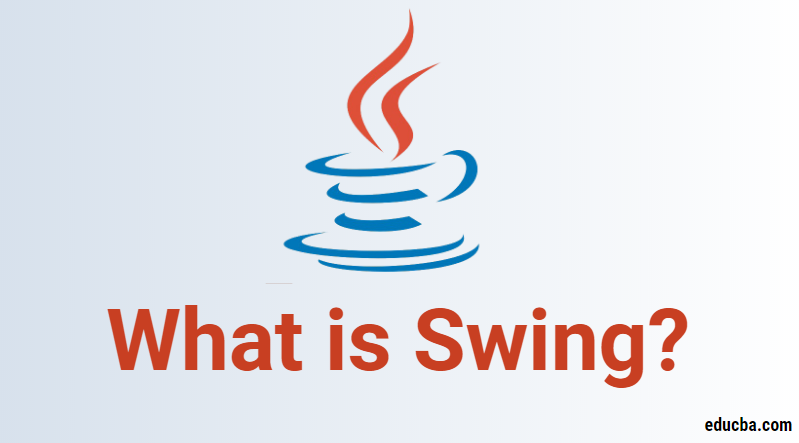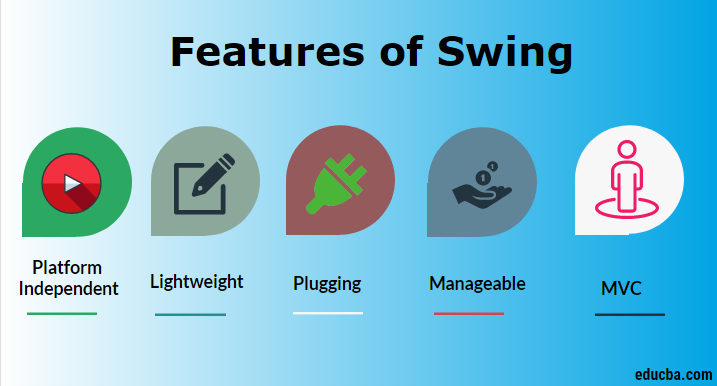Introduction to Swing
Swing is the collection of user interface components for Java programs. It is part of Java Foundation classes that are referred to as JFC. In simple terms, developers use Swing as a graphical user interface toolkit to create Java applications or programs specifically for Windows-based systems. It is the successor of AWT, known as the Abstract window toolkit API for Java, and AWT components are mainly heavyweight.
The components are lightweight as compared to AWT components. It provides an excellent interface to the user for all the platforms. It is not specifically for one platform. The components are written in Java and platform-independent as well. The Java foundation classes first appeared in 1997, then later called Swing. To use the Swing in Java, javax. A swing package needs to be used or imported. It is also known as Java Swing.
Features of Swing
The features of the Swing are as follows:
- Platform Independent: It is platform-independent; the swing components used to build the program are not platform-specific. It can be used on any platform and anywhere.
- Lightweight: Swing components are lightweight, which helps in creating the UI lighter. The swings component allows it to plug into the operating system user interface framework, including the mappings for screens or devices and other user interactions like keypress and mouse movements.
- Plugging: It offers a robust component framework that developers can extend to support the user interface, contributing to an appealing and consistent look and feel for the application. It refers to the highly modular-based architecture that allows it to plug into other customized implementations and frameworks for user interfaces. Its components are imported through a package called Javax. Swing.
- Manageable: It is easy to manage and configure. Its mechanism and composition pattern also allows changing the settings at run time. The user interface can receive uniform changes without modifying the application code.
- MVC: They mainly follow the concept of MVC, which is the Model View Controller. With the help of this, we can make changes in one component without impacting or touching other components. Swing earns its reputation as a loosely coupled architecture.
- Customizable: Swing controls can be easily customized. It can be changed, and the visual appearance of the component application is independent of its internal representation.
Examples of Swings,
The component class takes on a central role, frequently utilizing methods such as adding a component to another component (add(Component a)) and adjusting the size, layout, and visibility of components as needed.
Below is an example:
import javax.swing.*;
public class Test extends JFrame {
public Test() {
super("Test");
setDefaultCloseOperation(WindowConstants.EXIT_ON_CLOSE);
add(new JLabel("Test, Application!"));
pack();
setVisible(true);
}
public static void main(final String[] args) {
new Test();
}
}Other examples to show the button:
import javax.swing.*;
public class Swing {
public static void main(String[] args) {
JFrame f=new JFrame();//creating instance of JFrame
JButton b=new JButton("Submit Button");//creating instance of JButton
b.setBounds(120,90,90, 35);//x axis, y axis, width, height
f.add(b);//adding button in JFrame
f.setSize(400,500);//400 width and 500 height
f.setLayout(null);//using no layout managers
f.setVisible(true);//making the frame visible
}
}Difference between Swing and AWT
The difference between Swing and AWT are as follow:
| Basic Comparison | SWING | AWT |
| Architecture | It follows the model view controller architecture. | It doesn’t follow the model-view architecture. |
| UI | It does support a Pluggable look and feel for UI | It doesn’t support a pluggable look and feel |
| Components | It has a lot of components to provide for UI. | It has fewer components as compared to the Swing. |
| Independent | It is a platform Independent. | It is platform-dependent. |
| Weight | Its components are lightweight. | Its components are heavyweight. |
| Speed | If components are more used, it can be slow. | Its speed would be normal if components were used more. |
Advantages
The advantages are as follows:
- The Java swing mainly provides built-in double buffering.
- The new components are built-in swings, providing support for debugging.
- Swing components change the UI’s appearance, looks, and feels based on the used package.
- It earns its designation as “Lightweight” because it predominantly consumes fewer resources than AWT.
- It provides other components like icons, decorative borders, tooltips, etc.
- Because it adheres to the MVC design patterns approach, it primarily provides flexible UI.
- It provides additional functionality and other components to replace AWT components.
- The components and applications have the capability to be utilized or executed on any platform.
Disadvantages
The disadvantages are as follows:
- The components need version Java 1.2 and other separate jar files to consume.
- It can be slower than AWT.
- To develop the application in Swing, the individual has to be very careful with programming.
- Sometimes, the components have not appeared as they should.
Conclusion
Java Swing serves as the framework for building Windows-based applications in Java. It was developed to solve the issues that are in AWT. It provides more components to work and uses extensible components to build the applications. There are many components in the package or library to perform and define the look and feel of the project or application.
It is referred to as the next-generation GUI developed for Java programs. Java Swing is a platform-independent library of GUI controls. Its classes are lightweight because they do not create peer components. It mainly provides a consistent appearance or the look and feel of the application across all the platforms.
Recommended Articles
This has been a guide to the What is Swing? Here we discuss the Key Concepts, Features, Advantages, and Disadvantages. You can also go through our other suggested articles to learn more –





